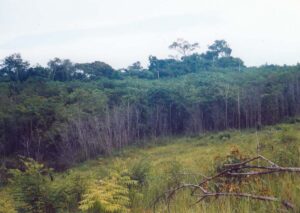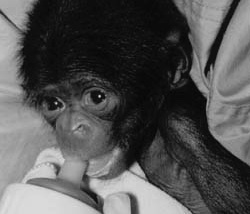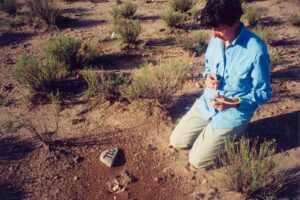Doug Foster
- 2000

Fellowship Title:
- Discoveries in Animal Behavior Research
Fellowship Year:
- 2000

An Amazon Preserve
What immediately strikes a newcomer upon entering the forest is how noisy it is, and how dark, beneath the canopy. Late last summer, I found myself standing in a preserve, a few hours drive from Manaus, Brazil in “continuous forest” which stretches for hundreds of miles to the Venezuela border. Leaves as big as your head rained down steadily, creating overlapping layers of brown, red, purple, and gray across the forest floor. A low roar from insects, including the leaf katydid, with its odd, bulbous mouth and spiky legs, built, pulselike, to periodic crescendos. Birds, including the scarlet macaw and yellow-ridged toucan, issued raspy calls. Marmosets and capuchin monkeys dropped detritus, cackling. The monkeys talked, bush dogs barked, wild pigs snuffled through the underbrush. The preserve, called Dimona, is an outpost run jointly by INPA, the Brazilian government’s forest research institute, and the Smithsonian Institution. One in a string of study centers spread across the Amazon, the preserve is part of an effort to understand what happens when unbroken subtropical forest is riven by roads,

The Future of Bonobos: An Animal Akin to Ourselves
Human tragedies often reverberate in unexpected ways, threatening environmental destruction and endangering other species. Consider the unfolding tragedy of the Congo, where continued fighting has caused the deaths of more than 1.7 million people in the past two years. Caught in the merciless crossfire of military forces from Uganda, Rwanda, and the Congo, villagers reportedly have fled into the jungle, where millions more now risk death from hunger, malaria, cholera, diarrheal diseases and H.I.V. Up to a third of those who have died so far are children under the age of five. A baby bonobo, named Zuri, gets a bottle at the San Diego Zoo. Zuri, which means “pretty” in Swahili, was born June 10, 1998 and was handraised in the nursery after being rejected by his young, inexperienced mother. Bonobos are a critically endangered species from the rainforests of Central Africa. The Zoological Society of San Diego has the largest bonobo population in the United States. (AP Photo/San Diego Zoo) This human catastrophe cascades down to affect other species. In the case of the

An Ant’s Life. Surprise: No One’s in Charge
Sunrise refracts over the Peloncillo Mountains, sending tendrils of light along the ground where biologist Deborah Gordon kneels in the dirt with an aspirator, sucking up dozens of ants. We’re in the desert a few hours drive from Tucson, where Arizona meets New Mexico, a sandy intersection that has provided the material for Gordon’s career-long quest to understand the social structure of this particular species of harvester ant, pogomyrmex barbatus. “Hitler could come to power and I wouldn’t know it,” Gordon murmurs, adjusting her wide-brimmed straw hat. “I’d be out here, sucking up ants.” Thwap! One moment the ants are tidying up their nest; the next they’re swept through a plastic tube to the bottom of her small glass vial. Gordon will chill these ants in a cooler (they respond to the cold by curling up, which will allow her to mark their backsides with green non-toxic model airplane paint). When they stir, she’ll return them to the nest, then laboriously track the peregrinations of individuals over the next several days. She’ll compare what happens
